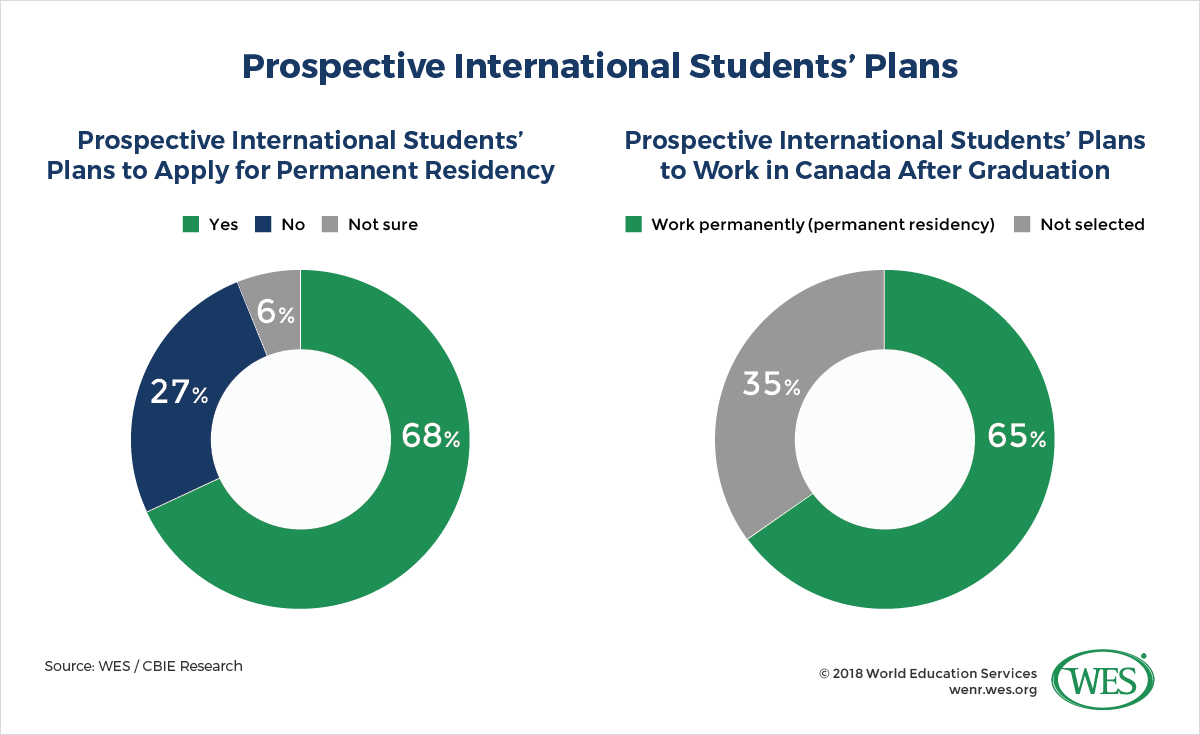Alejandro Ortiz, Senior Research Associate, WES
Over the past seven years, Canada’s international student flows have increased 119 percent [1]. This surge has become an important source of skilled immigrants, whom many Canadians view as one answer to a dwindling workforce, especially in less populous and aging provinces.
The Government’s Role
A decade of Canadian government policies that ease international students’ transition into Canadian society has provided powerful motivation. Such policies include increased [2] hours that international students can work and be paid; increased duration of post-graduation work permits [3] (certain conditions apply); the development of provincial immigration programs [4]; and more importantly, the awarding of additional points [5], under the current immigration point system, for being an international graduate of a Canadian college.
The Post-Graduation Work Permit program, which allows graduates to work and extend their stay in Canada, nearly doubled the number of permits issued [7] from 18,000 in 2008 to 34,000 in 2015. More recent IRCC data [8] show that in 2017 there were 114 thousand permit holders, up from 15.6 thousand in 2008. Also worth noting is the latest report from the Canadian Bureau for International Education’s A World of Learning, [7] which states that “… many international students transition to permanent residency after entering the workforce through a post-graduation immigration pathway.”
But questions remain about other factors that motivate prospective students from abroad to come to Canada with the intent of staying after graduation.
Other Factors Behind Prospective Students’ Desire to Stay: New Insights
To shed further light on these prospective Canadian students from abroad, World Education Services [10], in partnership with the Canadian Bureau for International Education [11] (CBIE) and Pathways to Prosperity: Canada [12], surveyed more than 1,100 self-identified international students in late 2017. Almost 300 respondents identified as prospective students. We analyzed their responses to better understand three main questions:
- What are the main motivations of international students who want to study in Canada?
- What are the expectations of international students regarding institutional assistance to transition to permanent residency?
- Which factors predict an international student’s intentions to seek permanent residency in Canada?
Early Insights
Responses confirmed, at the broadest level, what has long been clear: A large percentage of prospective international students plan to work in Canada after graduation (65 percent), and to apply for permanent residency (68 percent).
But researchers also obtained some deeper insights. For instance, many students seek to stay because Canada offers a better standard of living than many students’ home countries (59 percent); and Canada has better job opportunities (52 percent). (These findings align with those of Statistics Canada [13], which previously found that a student’s country of origin affects transition rates.)
Of students who intend to apply for permanent residency, 59 percent expect their educational institutions to help them make professional connections in Canada.
Regarding other predictors of intentions to seek permanent residency, the researchers found several other factors that correlate with intent to stay in Canada as permanent residents:
- Students who received financial support from on- or off-campus work, a paid internship, or a co-op were 1.25 times more likely to express the intention of applying for permanent residence.
- International students who had friends who were Canadian students, or a mixture of Canadian and international students, were 1.44 times more likely to express the intention of applying for permanent residence.
- Compared with international students who studied in British Columbia, those who studied in the Prairie Provinces—Manitoba, Saskatchewan, and Alberta—were 1.5 times more likely to express the intention of applying for permanent residence.
- Also, international students pursuing a degree in engineering were 1.34 times more likely to express the intention of applying for permanent residence than international students in the “rest and other” category.
- And finally, international students who had previously studied in Canada were 1.81 times more likely to express the intention of applying for permanent residence than international students who had not.
With this information, public policymakers and international admissions officers at higher education institutions can reassess their views and practices. For example:
- Those in international admissions can strengthen policies that integrate international students with their Canadian peers.
- Admissions officers can stress their institution’s ability to connect students to professionals in their fields.
- Public policymakers can create a federal pathway to permanent residency for international engineering graduates.
Further Research
The research partnership intends to explore several other areas of study; for example, the role student satisfaction with the institution or program plays in students’ plans to pursue permanent residency.
The partners believe that to effectively address long-term integration of students and labor gaps, it’s critical to understand postgraduate employment success. To facilitate that understanding, this project will dig deeper into the different paths immigrants take, and how those paths contribute to differences in the labor outcomes of international students and those of other immigrants.
The full report, “Retaining International Students in Canada Post-Graduation: Understanding the Motivations and Drivers of the Decision to Stay [14],” is available on the CBIE website.

